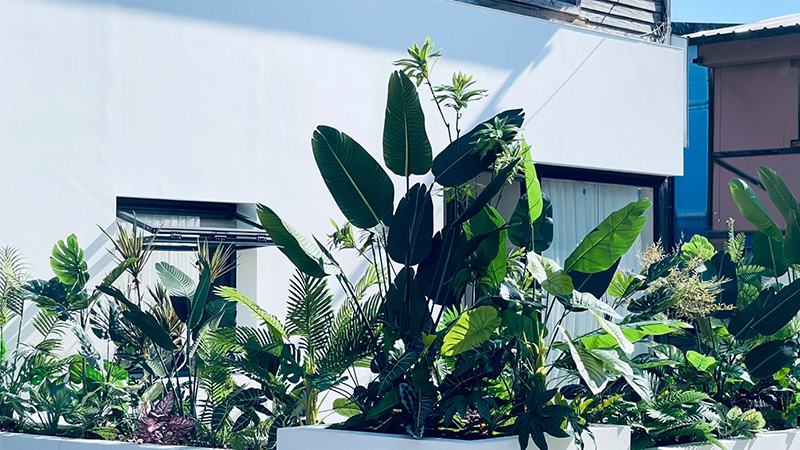Sometimes, the charm of outdoor decor is ruined by faded, brittle artificial plants. This problem often arises when these plants aren't UV-resistant1. The solution? Incorporate materials and coatings that shield them from the sun’s harmful rays.
UV-resistant artificial plants are designed to withstand sunlight exposure without fading or cracking.
Most of us want outdoor spaces to look vibrant and fresh year-round. But ordinary artificial plants often fail under harsh sunlight. By understanding UV resistance2, you can maintain an appealing outdoor look without constant replacements.
How do you make fake plants UV resistant?
Creating UV-resistant artificial plants3 isn’t rocket science, but it does require some know-how. Manufacturers use UV inhibitorsand special coatings to protect plants from sun damage.
Key steps involve adding UV inhibitors to materials and applying protective sprays.
ALT: Spraying artificial plants, close-up of gloved hand spraying leaves in factory, enhancing product quality
Title: Artificial plant production
When it comes to UV resistance, not all methods are equal. Here's a breakdown:
Material Integration
- Step 1: Use polyethylene or polyvinyl chloride (PVC) for durability.
- Step 2: Blend UV inhibitors during the molding process.
Surface Treatments
- Spray-on Coatings: These provide additional UV protection but require periodic reapplication.
- Embedded Protection: Offers better longevity since the protection is built-in rather than applied on top.
| Method | Advantages | Disadvantages |
|---|---|---|
| Embedded UV Protection | Long-lasting, minimal maintenance | Slightly more expensive upfront |
| Spray-on Coating | Cost-effective, easy to apply | Needs frequent reapplication |
UV-resistant plants are made by blending UV inhibitors into the materials. True
This ensures even protection and longer lifespan.
Spray-on UV protection lasts forever.False
External coatings wear off and need reapplication over time.
How long do UV-resistant plants last?
Artificial plants designed with UV resistance don’t last forever, but they hold up remarkably well. Under proper conditions, they can stay vibrant for years.
UV-resistant artificial plants can maintain their look for 5-10 years, depending on exposure levels.
ALT: Outdoor artificial plant arrangement, modern planter boxes with lush green artificial foliage
Title: Outdoor artificial plants
Durability depends on factors like sun intensity, material quality, and care. For example, plants in milder climates may last longer than those in constant direct sunlight.
Tips for Extending Lifespan
- Rotate plants periodically to prevent uneven exposure.
- Clean surfaces to remove dust that might reduce UV protection.
- Avoid placing them under intense, unfiltered sunlight when possible.
| Climate Type | Expected Lifespan |
|---|---|
| Mild/Temperate | 8-10 years |
| Hot/Sunny | 5-7 years |
Cleaning UV-resistant plantsTrue
Dust and dirt can block UV protection layers over time.
UV-resistant plants are indestructible.False
Even with UV protection, exposure and wear will degrade materials eventually.
Can you keep artificial plants outside?
Yes, you can, but choosing the right kind of artificial plantis crucial. Ordinary plants fade and crack outdoors, while UV-resistant options are specifically designed for outdoor environments.
UV-resistant artificial plants can thrive outdoors without significant damage for years.
ALT: Minimalist artificial tree design, indoor artificial bonsai with rocks and green accents
Title: Artificial bonsai tree
When placing artificial plants outdoors, consider additional factors: weather conditions, positioning, and cleaning routines.
Best Practices for Outdoor Use
- Position Wisely: Place plants where they get partial shade during peak sun hours.
- Anchor Properly: Secure them against strong winds.
- Regular Maintenance: Wipe with a damp cloth to remove grime.
| Scenario | Recommendation |
|---|---|
| Constant Sun Exposure | Use plants with embedded UV protection. |
| Windy Conditions | Anchor pots with heavy bases. |
| Rainy or Humid Environments | Select weather-resistant materials. |
They are specifically made to endure sunlight without rapid deterioration.
Any artificial plantFalse
Non-UV-resistant plants degrade quickly under sunlight.
Conclusion
UV-resistant artificial plants combine durability and beauty, making them a practical choice for outdoor spaces. Choose wisely, maintain them well, and enjoy vibrant greenery for years.
-
Understanding UV inhibitors helps in choosing high-quality artificial plants that resist sun damage. ↩
-
Knowing the lifespan of UV-resistant artificial plants ensures proper maintenance and expectations for outdoor use. ↩
-
Learning about UV protection application methods helps in extending the life of artificial plants. ↩

Hello everyone, I'm Li!By day, I'm a seasoned expert in the artificial plant industry, starting from the factory floor and working my way up to running my own successful business. In my free time, I’m passionate about running and often join trail runs with friends.Here to share what I've learned—let's grow together!






